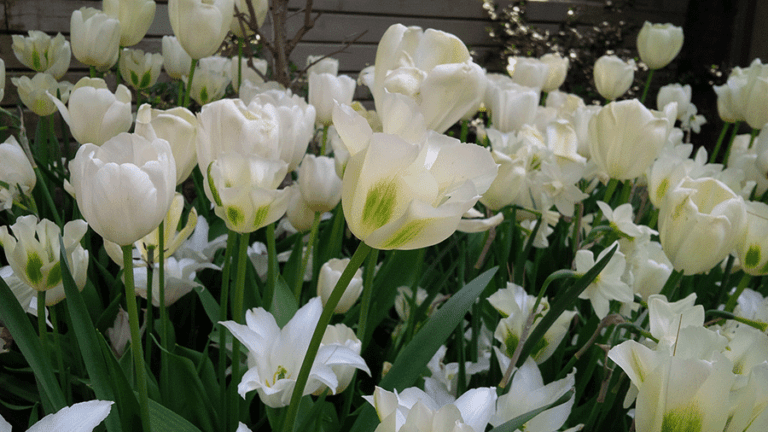
Think of the colour white and the image of a wedding dress, eggs or snow will likely spring to mind. But with a little stretch of your imagination, visualize instead a small corner bed or a border around a patio filled with white plants. Single-colour schemes are sometimes referred to as “monochromatic” — a term that takes the romance out of any flower arrangement — but be assured, a white border can offer dynamic interest, a cool and refreshing perspective, and even a surprising diversity of hues.
White isn’t just one colour, but many representations of whiteness expressed in related tones. Think of milky white, stark white, off-white, eggshell white, ghost white, warm white, bone white, antique white. Consider the starkly bright white of lily-of-the-valley (Convallaria majalis) bells and the pale milky white of pheasant’s eye daffodil (Narcissus poeticus); the creamy white of foamflower (Tiarella spp. and cvs.) and the greyish-white of baby’s breath (Gypsophila paniculata).
White represents so many differing tones because it often appears with another colour influence insinuated into the mix from a petal reverse or foliage. For instance, the fine, pale blue line along each petal of striped squills (Puschkinia libanotica), an early spring bulb, lends a blue cast to an essentially white flower. The slight pink echo in white gaura flowers (Gaura lindheimeri) comes from a faint pink blush across the petal reverse.
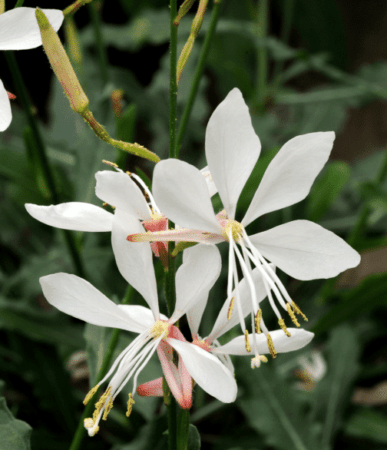
A white border adds focus to a garden and is a specially designed feature where light is caught and bounced back by petals and foliage, creating a clear statement that says: this is a cool, calm and refreshing place. Deeply saturated jewel tones, such as gold, red and violet, absorb light, doing nothing to alleviate darkness. White does just the opposite. Because it reflects light, it brings brightness and clarity to part shade, and dazzling brilliance to sunny locations. White does for a garden what a fine lens does for a camera — brightens and clarifies the image; detail in plant form and garden composition is revealed.
Day or night, a collection of white plants glows with energy and sensual attraction. White flowers are often highly perfumed, and the scents of plants like tall flowering tobacco (Nicotiana alata) and ‘Casa Blanca’ oriental lilies have considerable appeal to romantic natures.
A grouping of plants with white flower petals and variegated white-and-green foliage to catch attention and pique interest can fit into any space. Small side gardens or obscure narrow strips running along a garage from front- to backyards are ideal locations. Areas that are dull at night will take on a refreshing and brighter character with white plants. A separate area designated as a white zone can provide contrast for traditional colours in other garden areas, and take advantage of a previously undistinguished space. Perhaps an established border that has been predominantly pink for several years could benefit from a renovation, removing tired plants that haven’t excelled and installing a significant white presence to partner with the remaining pinks.
White flowers and foliage contribute to every garden plan, and are especially effective when placed near dark conifers. A white border in front of a cedar or yew hedge makes a special kind of magic, bringing light and character to a dull, stagnant setting.
Two planting designs using white flowers
Even when an area is small, treat the space as a landscape requiring all plant categories, as well as architectural features where appropriate, such as rocks and small arbours, trellises and other plant supports. Small trees and shrubs, perennials, groundcovers and a flowering vine will add layered dimension to the planting scheme, and opportunity for contrasting forms and patterns.
As with every bed or border design, large woody plants (one or more) anchor the setting. A small space might accommodate only one of each plant form, while a larger site could hold multiples of each. Selecting plants that will display white features from spring through fall is key to sustaining a colour theme that resonates through the full growing season. As a finishing touch, small ornamental elements can be included — a birdbath for the part shade garden or a sundial for the sunny border, for example.
Option 1: White planting scheme for part shade
Spring begins with the furry grey buds of star magnolia opening to bright white flowers in frosty air. Lemon-scented star magnolia flowers unfurl on bare branches, and are followed by crisply distinctive foliage. ‘Sissinghurst’ lungwort is an early groundcover that will make neat mounds around the ankles of the magnolia, spreading out pointed leaves spotted with white and displaying many stems of white bell-shaped blooms held above the foliage. Several clumps will expand to effectively cover the ground and provide attractive foliage through summer. Lungwort blooms for several weeks in cool spring conditions, and is followed shortly by ‘White Nancy’ deadnettle. Each small deadnettle mound sends out creeping tendrils of bright silver-white foliage and white flowers, forming an effective groundcover until frost. ‘White Nancy’ will ramble freely, making shallow roots as it moves along, and create a soft carpet without interfering with plant neighbours.
Woody shrubs with long seasons of display are the backbones of the garden. Ivory Halo dogwood is a key plant, its delicately pointed green leaves widely margined with pure white shining against dark red twigs. Happiest in consistently moist soil, ‘Kyushu’ panicle hydrangea will offer a generous show of large, white panicle blossoms from midsummer until frost. ‘Hummingbird’ summersweet relies on consistent moisture, too; it will cover its compact mound of foliage with deeply scented white racemes in mid- to late summer.
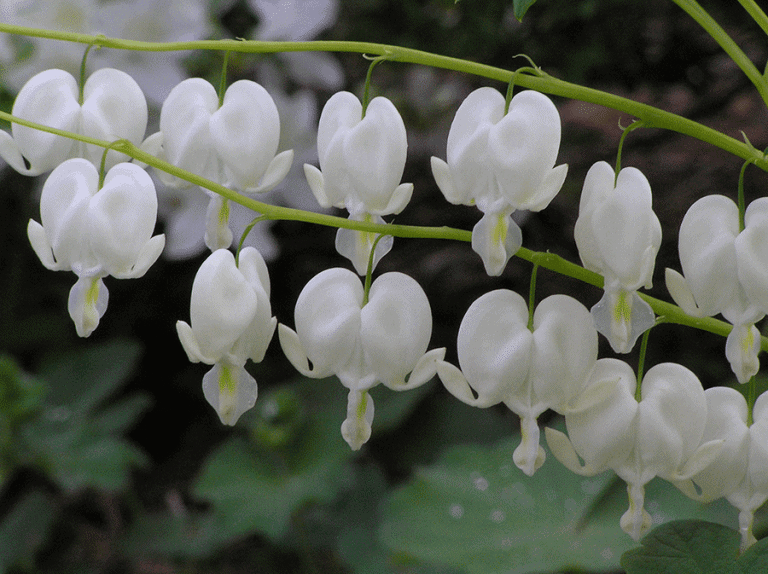
White bleeding hearts are focal points in the mid-spring garden, extending their wands of dangling lockets that bounce along in the breeze. Set them with a good neighbour like ‘Jack Frost’ bugloss, which sends up wiry stems of tiny, blue forget-me-not flowers over silver-white-washed leaves that will last all season. White bloody cranesbill is a perfect filler plant, easy to fit into spaces between shrubs, where its fine, textured foliage and clear-white flowers sparkle from mid-spring through midsummer.
When many perennials are finished blooming, count on white turtlehead to send up spikes of large hooded flowers, attractive to hummingbirds and lasting from late summer through early fall.
If there is space for a trellis or obelisk, satin-textured ‘Marie Boisselot’ clematis will put out large numbers of white blossoms with only two hours of daily sun, blooming for a full 10 weeks.
PLANT LIST
(Dimensions are height x width)
Woody plants:
- ‘Hummingbird’ summersweet (Clethra alnifolia ‘Hummingbird’); 40 x 48 in. (1 x 1.2 m); Zone 5
- Ivory Halo dogwood (Cornus alba ‘Bailhalo’); 5 x 5 ft. (1.5 x 1.5 m); Zone 4
- ‘Kyushu’ hydrangea (Hydrangea paniculata ‘Kyushu’); 5 x 5 ft. (1.5 x 1.5 m); Zone 4
- Star magnolia (Magnolia stellata); 8 x 10 ft. (2.5 x 3 m); Zone 5
Perennials and vines:
- ‘Jack Frost’ bugloss (Brunnera macrophylla ‘Jack Frost’); 18 x 18 in. (45 x 45 cm); Zone 3
- White turtlehead (Chelone obliqua var. alba); 36 x 24 in. (90 x 60 cm); Zone 4
- ‘Marie Boisselot’ clematis (Clematis ‘Marie Boisselot’); 8 ft. (2.4 m); Zone 5
- White bloody cranesbill (Geranium sanguineum ‘Album’); 12 x 30 in. (30 x 75 cm); Zone 4
- ‘White Nancy’ spotted deadnettle (Lamium maculatum ‘White Nancy’); 8 x 18 in. (20 x 45 cm); Zone 3
- White bleeding heart (Lamprocapnos spectabilis ‘Alba’); 36 x 36 in. (90 x 90 cm); Zone 3
- ‘Sissinghurst White’ lungwort (Pulmonaria ‘Sissinghurst White’); 12 x 24 in. (30 x 60 cm); Zone 3
Option 2: White planting scheme for sun
In mid-spring, classic pink apple blossom buds on a Lollipop crabapple swirl open to reveal sparkling white petals. With the passage of summer, each flower turns to a golden fruit, tiny enough to cling on and provide food for birds. Lollipop crabapple is a dwarf tree that responds well to pruning, and can be kept to a densely rounded form, making an interesting anchor for a sunny bed.
Rose of Sharon is a strong vase-shaped shrub for anchoring the end of a border, and the white flowers of ‘Jeanne d’Arc’ are so fully double, they look like small peonies. The white-margined foliage of Siberian dogwood is a softening influence, but its intensely red bark will glow in the winter garden when all leaves have fallen. Hydrangeas are invaluable for their long season of bloom, with flowers opening from early- to midsummer and lasting through to frost. Incrediball smooth hydrangea has hundreds of creamy white florets gathered into each large domed head, with the benefit of stout stems that won’t buckle under the weight.
‘Bressingham White’ bergenia foliage rises in early spring, pushing broad, shiny leaves out of the ground that frame spikes of dazzling white, bell-shaped flowers that age to soft pink. Bergenia looks best when planted in groupings of three or five, and makes an interesting groundcover near small trees like dwarf crabapple, or as an edging for the front of a planting bed. Snow-in-summer is a mat-forming groundcover, spreading its stems along the ground in a thick cushion of soft, light grey leaves, with slender stems rising above carrying masses of sparkling white flowers in mid-spring.
The intense white, cupped petals of ‘Jan van Leeuwen’ peony surround an impressive centre of golden stamens. This single, early peony doesn’t require support, even after a rain, and has lemon-scented petals that close at night. Following in successive bloom, the ferny clumps of ‘Diamond’ astilbe send up their large, plume-shaped white flowers in late spring, which can be left standing for ornamental effect through the following winter.
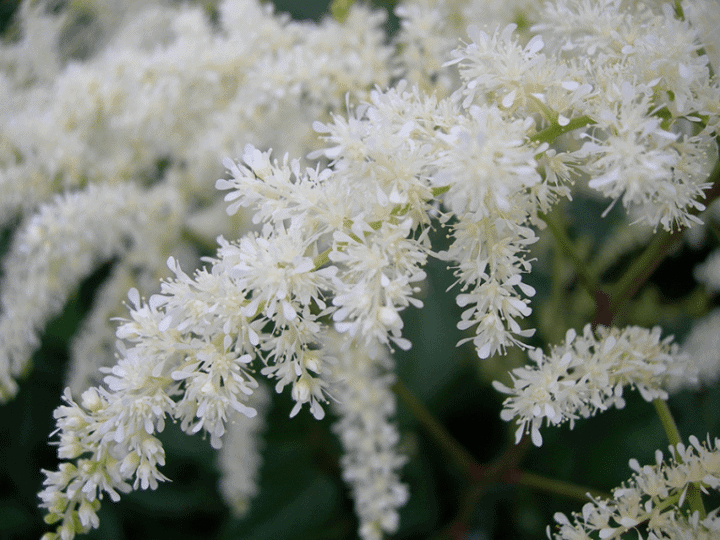
Every garden benefits from a plant with beauty and great architecture, as can be expected from the statuesque ‘Galahad’ delphinium. ‘Galahad’ is a moderately tall delphinium with sturdy stems that resist pressure from winds; it flowers for several weeks as side shoots develop after the central bloom stalk finishes. As a complement to the tall delphinium, ‘White Swan’ coneflower is a long-blooming companion. It sends up several flower stalks from a low clump with eggshell-white ray petals surrounding broad, bronze cones.
Where there’s room for a short vine, white everlasting pea is a scrambler that can be tied to a fence post or arbour. Each year it produces increasingly more dazzling white sweet pea flowers from midsummer through early fall.
PLANT LIST
(Dimensions are height x width)
Woody plants:
- Variegated dogwood (Cornus alba ‘Sibirica Variegata’); 5 x 5 ft. (1.5 x 1.5 m); Zone 4
- ‘Jeanne d’Arc’ rose of Sharon (Hibiscus syriacus ‘Jeanne d’Arc’); 8 x 5.5 ft. (2.5 x 1.75 m); Zone 6
- Incrediball smooth hydrangea (Hydrangea arborescens ‘Abetwo’); 48 x 48 in. (1.2 x 1.2 m); Zone 4
- Lollipop crabapple (Malus ‘Lollizam’); 8 x 8 ft. (2.5 x 2.5 m); Zone 5
Perennials and vines:
- ‘Diamant’ astilbe (Astilbe ‘Diamant’ (x arendsii); 30 x 24 in. (80 x 30 cm); Zone 4
- ‘Bressingham White’ bergenia (Bergenia ‘Bressingham White’); 16 x 24 in. (40 x 60 cm); Zone 3
- Snow-in-summer (Cerastium tomentosum); 6 x 24 in. (15 x 60 cm); Zone 3
- ‘Galahad’ delphinium (Delphinium ‘Galahad’ [Pacific Hybrid Series]); 48 x 18 in. (120 x 45 cm); Zone 3
- ‘White Swan’ coneflower (Echinacea purpurea ‘White Swan’); 24 x 12 in. (60 x 30 cm); Zone 5
- White everlasting pea vine (Lathyrus latifolius ‘Albus’); 5 x 3 ft. (1.5 m x 90 cm); Zone 4
- ‘Jan van Leeuwen’ peony (Paeonia lactiflora ‘Jan van Leeuwen’); 24 x 24 in. (60 x 60 cm); Zone 3
More about white colour
White is an ancient and classic colour in the natural landscape. Many species plants have white flowers, without benefit or assistance from plant breeding, and pollinator species have evolved to assist the reproduction of white plants. Particular species of bats and moths are drawn to scented white petals, performing their pollination duties in the darkness of night.

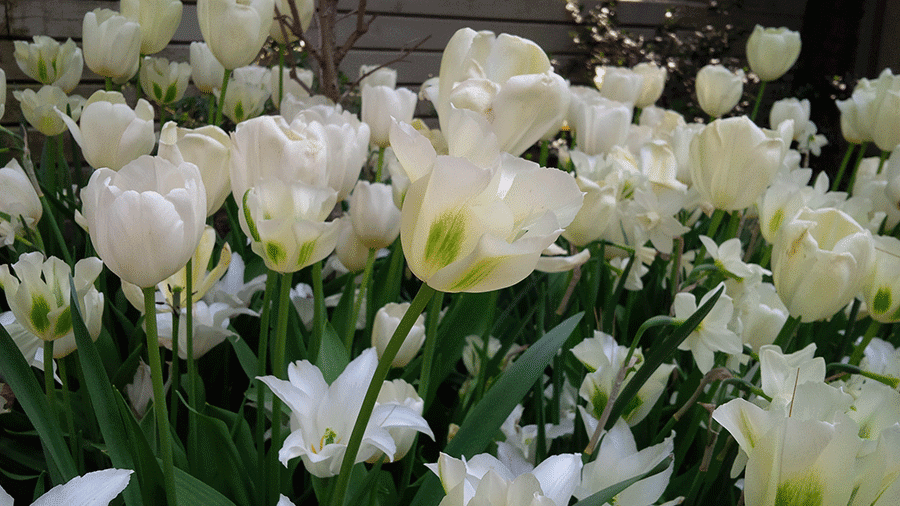
Beautiful white astilbe! Which variety is it?
Perfect! Awesome timing for me as I am in the middle of planning a White ‘scented’ garden.
I have rid my patch of what I call ‘green meatballs’, as they have no flow
or attraction for butterflies and humming birds. This summer I added grasses, white roses, turtle head, coneflower and ice pansies. White flowering bulbs for spring are next. Hopefully that will give me the beginning of the garden that I visualize Pamela
I have a type of sissinghurst white garden and love to add GREYS to it,. One good grey foliage is Large Leafed Sage. and Another is Argentia. Try them in between or in the front of the border.
And for annuals added yearly I love Double White Cosmos,”Psyche”
Georgina Rodrigues, Guelph